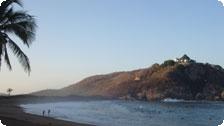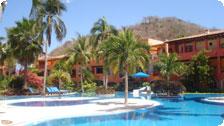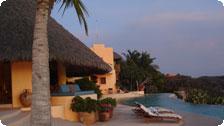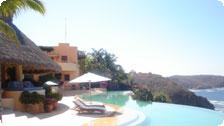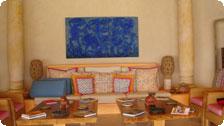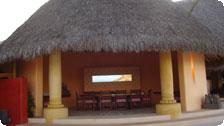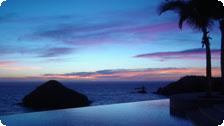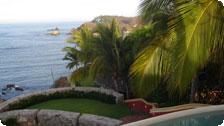Culture: El Careyes, Mexico: The secret, decadent and exclusive jet setter’s hideaway
by Felicia Kamriani
About an hour north of Manzanillo Airport and two hours south of Puerto Vallarta lies the serenely decadent getaway of Costa Careyes, or Turtle Coast. This breathtaking oasis, consisting of the 48-room El Careyes Beach Resort, charming Las Casitas de Flores, and multimillion-dollar private villas surrounded by 30,000 acres of natural habitat offers sophistication and privacy to an in-the-know array of visitors who holiday there each year.
The idea for this serene paradise was born when Italian entrepreneur Gian Franco Brignone arrived in the area in 1968. There, he encountered a blank canvas of a coast on which to create a sanctuary for visitors and nature alike. Incorporating a deep respect for the area’s history and ecology along with modern and traditional sensibilities, Brignone and his architects designed retreats that offered expansive ocean views and luxurious dwellings. Word spread, and soon European jetsetters, Hollywood celebrities, and other international travelers alike were flocking to this tropical getaway to live, visit, and unwind.
El Careyes Beach Resort
The entrance to the tranquil El Careyes Beach Resort is easy to miss, but as I make the turn and pass through the gates, I enter a lush world of natural elegance. Winding down the pebbled driveway lined by rich rainforest, I notice my breath deepening and my thoughts clarifying.
The resort’s entrance archway frame the infinity free-form pool within and the Pacific Ocean beyond. Once on the golden-sand beach, I discover how truly secluded the private cove is, blending seamlessly with the lushness of nature around it. Straight ahead, a few giant island rock formations rise out of the ocean; private homes perch atop towering cliffs on both sides, and behind me, Las Casitas meshes harmoniously into the lush hillside.
Yet El Careyes Beach Resort is not only special for its natural seclusion. This Pueblo-style boutique hotel specializes in personalized service and fantastic international cuisine. Couples can dine by torchlight at the romantic Terrace Restaurant, which also boasts the best Margaritas I’ve ever tasted. During the day, cushioned couches along the same beach make it ideal for lounging, daydreaming, or napping.
The resort offers limitless choices of services and amenities, including tennis, spa, a fitness center, hiking, golf, horseback riding, and water sports. One of my favorite spots, however, was the neighboring ultra-chic Polo Club, where I attended an Audi-sponsored tournament. Among the cocktails, cars, and designer-clad attendees, I picked up a smattering of Spanish and English conversations that included, among other topics, how to fly the Argentinean Polo horses one had purchased into the local stables. Truly, I had landed on a movie set.
Surrounding Areas
Highlights of my stay at El Careyes included exploring the nearby coves and secluded beaches. Teopa Beach lies at the end of a long, rocky road that winds past the Polo Club. It is a stunning expanse of sand, void of anything but waves and a few locals on horseback as far as the eye can see. Teopa Beach is also home to giant sea turtles (hence the name Careyes), which wander ashore to lay their eggs.
Another private crescent shaped beach, Playa Careyitos, is a short seven-minute walk south of the hotel. Secluded save for a small rustic fish shack and the equally diminutive El Cocodrilo beach club, this pristine cove offered breathtaking views of two Brignone clifftop masterpieces: Casa Sol de Oriente and Casa Sol de Occidente, two homes completely encircled by swimming pools and views that can be had for $6,000 a night.
Continuing past Playa Careyitos, the path winds through more nature preserves that include a forest and a lagoon. After seeing a real crocodile sink stealthily into the water, I was petrified I wouldn’t make it back alive, let alone refreshed!
North of the hotel, I encountered Playa Rosa, a private beach for the exclusive use of Hotel and Casita guests and Careyes residents. This peaceful cove is the ideal for long swims because motorized equipment is not allowed. Playa Rosa features a small restaurant in an open-air, quaint setting. For those preferring this ultimate secluded spot, three beachfront bungalows offer an intimate hideaway.
Nestled in between Playa Rosa and El Careyes Resort are the Casitas de las Flores. These one- and two-bedroom cliff-hanging villas include kitchens, living rooms, private plunge pools, and terraces.
Private Villas
What sets Costa Careyes apart from other vacation destinations is not just the privacy or the beauty, but the exclusivity. The most luxurious dwellings in all of Careyes (and indeed in the world) are the multi-million dollar private villas, where many of the world’s elites have created their vacation homes. While some villas remain empty for much of the year, others can be rented from $900 to $7,500 a night. Each unique and magnificent in its own right, the homes share a common distinction in their explosion of color.
I had the pleasure of staying at the private villa of Casa Luna, where hues and textures radiate throughout. Coconut trees and bougainvillea sprouted along the circular drive and geckos greeted me cheerfully. A bubbling fountain beaconed me from within the villa toward an infinity pool, which appeared to flow off the cliff and into the Pacific. The effect was one of spiritual oneness and utter magic.
On several occasions, I dined with architect Manolo Mestre, who designed Casa Luna in collaboration with its owner, Beverly Hills businessman Christophe Tribull. Mestre takes inspiration from the colors and elements of the natural surroundings, incorporating the furniture and artwork of local artisans into his work, along with symbols of the ancient Aztecs and vivid indigenous flowers. Yet indoors, amid the juxtaposition of natural and man-made materials, of polished surfaces and textures, one also encounters a seamless unity with the natural beauty that surrounds the villa.
All of the private homes Mestre creates on the coastal rim center around a palapa, an open-air, informal living room with a high thatched ceiling that Mestre calls “a breathing space for the rest of the house.” The Casa Luna palapa offers both the richness of a living room and the openness of an outdoor space. Rounded walls and smoothed edges create a flow from one room to the next, a fusion of inside and outdoors. The result is a dwelling that is both cozy and expansive, surrounded by — and welcoming of — the nature enveloping it. Hummingbirds float freely, while giant pelicans and even vultures soar close by.
The unifying element that permeates all of the residences, however, is the incredible sunsets. From all viewpoints, the commanding view is equally spectacular.
For more information:
Discover more from Tango Diva
Subscribe to get the latest posts sent to your email.
